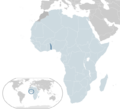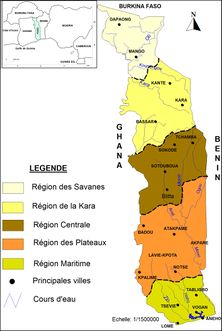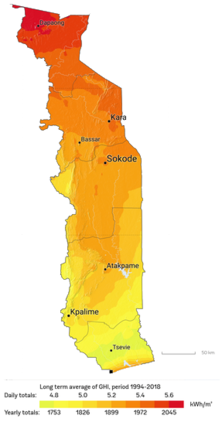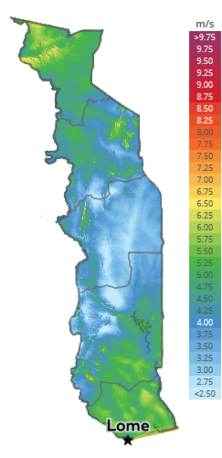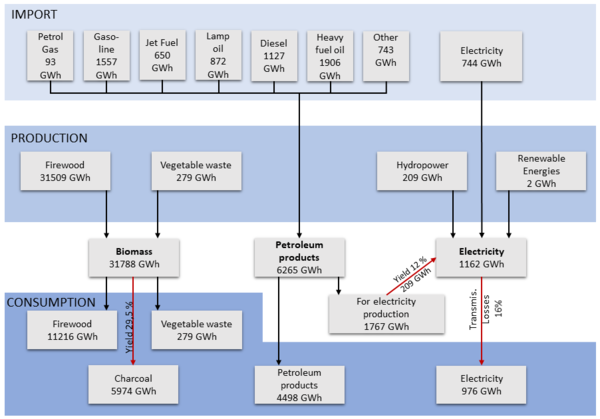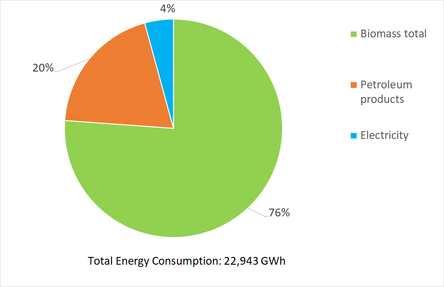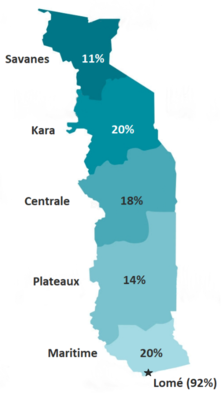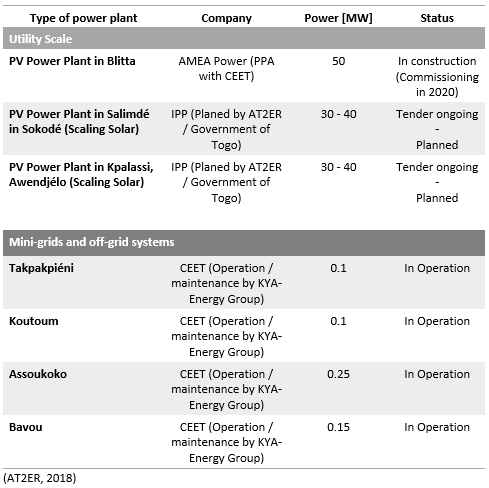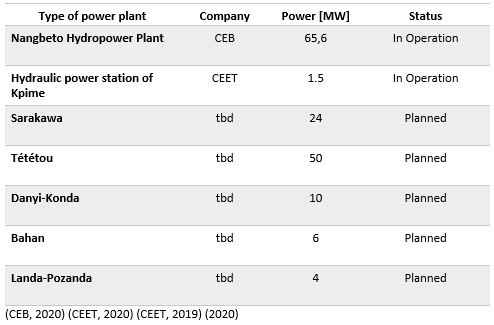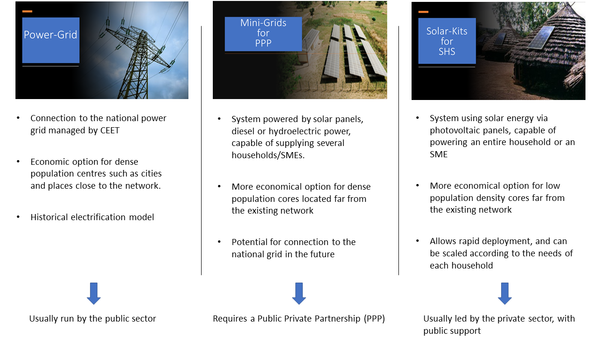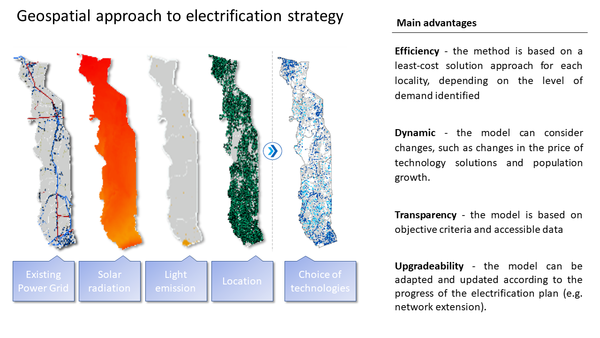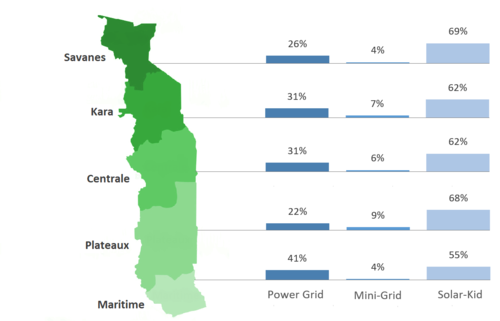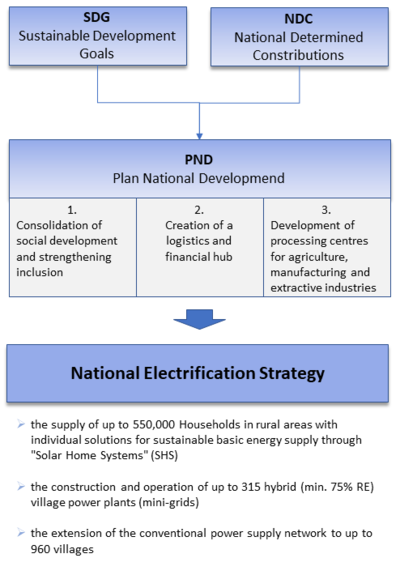Knowledge fuels change - Support energypedia!
For over 10 years, energypedia has been connecting energy experts around the world — helping them share knowledge, learn from each other, and accelerate the global energy transition.
Today, we ask for your support to keep this platform free and accessible to all.
Even a small contribution makes a big difference! If just 10–20% of our 60,000+ monthly visitors donated the equivalent of a cup of coffee — €5 — Energypedia would be fully funded for a whole year.
Is the knowledge you’ve gained through Energypedia this year worth €5 or more?
Your donation keeps the platform running, helps us create new knowledge products, and contributes directly to achieving SDG 7.
Thank you for your support, your donation, big or small, truly matters!
Difference between revisions of "Togo Energy Situation"
***** (***** | *****) |
***** (***** | *****) |
||
| Line 78: | Line 78: | ||
The total energy consumption of 22.943 GWh is divided into 4% electrical energy, 20% petroleum products and 76% biomass. A large part of this energy is consumed in households (73.5%), followed by the transport sector (13.2%) and the market sector (10.1%). Industry consumes a share of 3%. Households use mainly wood as a direct form of energy (56.9%) but also charcoal (33.7%). Electricity is used as a form of energy in 3.6% of households. In the transport sector, a lot of petrol (46%) and diesel (35%) is used. In industry, there is an even distribution in the consumption of electricity (36%), diesel (37%) and fuel oil (27%). (SIE, 2017) | The total energy consumption of 22.943 GWh is divided into 4% electrical energy, 20% petroleum products and 76% biomass. A large part of this energy is consumed in households (73.5%), followed by the transport sector (13.2%) and the market sector (10.1%). Industry consumes a share of 3%. Households use mainly wood as a direct form of energy (56.9%) but also charcoal (33.7%). Electricity is used as a form of energy in 3.6% of households. In the transport sector, a lot of petrol (46%) and diesel (35%) is used. In industry, there is an even distribution in the consumption of electricity (36%), diesel (37%) and fuel oil (27%). (SIE, 2017) | ||
| + | |||
| Line 98: | Line 99: | ||
Currently, an electrical power of 230,000 kW is produced in the country. It is estimated that in 2030 a total of 100,800,000kW of electricity will have to be produced to supply the entire population with electricity. (PERC, 2015) (Global Lightning, 2018) | Currently, an electrical power of 230,000 kW is produced in the country. It is estimated that in 2030 a total of 100,800,000kW of electricity will have to be produced to supply the entire population with electricity. (PERC, 2015) (Global Lightning, 2018) | ||
| − | The National Electrification Strategy was developed to realize this (see chapter 6). With this project, the government of Togo has set itself the goal of expanding renewable energy in particular and implementing various new strategies to provide universal access to electricity. The focus is on the expansion of solar energy for the electrification of rural areas. In addition, new opportunities for hydropower are to be developed. This technology has so far only been used in large-scale projects. In the future, however, smaller plants are also to be implemented. (CIA, 2016) (Worldbank, 2017) (SET, 2018)<br/> | + | The National Electrification Strategy was developed to realize this (see chapter 6). With this project, the government of Togo has set itself the goal of expanding renewable energy in particular and implementing various new strategies to provide universal access to electricity. The focus is on the expansion of solar energy for the electrification of rural areas. In addition, new opportunities for hydropower are to be developed. This technology has so far only been used in large-scale projects. In the future, however, smaller plants are also to be implemented. (CIA, 2016)<ref name="Worldbank. 2017. Worldbank. [Online] 2017. http://documents.worldbank.org/curated/en/918921468338492241/pdf/multi-page.pdf.">Worldbank. 2017. Worldbank. [Online] 2017. http://documents.worldbank.org/curated/en/918921468338492241/pdf/multi-page.pdf.</ref> (Worldbank, 2017) (SET, 2018)<br/> |
| − | <div><br/></div><div>'''[[File:Table1 Overview of the energy sector in Togo.PNG|thumb|center| | + | <div><br/></div><div>'''[[File:Table1 Overview of the energy sector in Togo.PNG|thumb|center|600px|Table: Overview of the energy sector in Togo. The data was compiled from various sources and provides information on the current electrification rate, electricity production and consumption. The table also shows the electricity production costs compared to the electricity price and the different types of electricity production.]]'''<br/></div> |
| − | |||
Revision as of 12:33, 2 June 2020
Capital:
Lomé
Region:
Coordinates:
6.7° N, 1.13° E
Total Area (km²): It includes a country's total area, including areas under inland bodies of water and some coastal waterways.
XML error: Mismatched tag at line 6.
Population: It is based on the de facto definition of population, which counts all residents regardless of legal status or citizenship--except for refugees not permanently settled in the country of asylum, who are generally considered part of the population of their country of origin.
XML error: Mismatched tag at line 6. ()
Rural Population (% of total population): It refers to people living in rural areas as defined by national statistical offices. It is calculated as the difference between total population and urban population.
XML error: Mismatched tag at line 6. ()
GDP (current US$): It is the sum of gross value added by all resident producers in the economy plus any product taxes and minus any subsidies not included in the value of the products. It is calculated without making deductions for depreciation of fabricated assets or for depletion and degradation of natural resources.
XML error: Mismatched tag at line 6.2 ()
GDP Per Capita (current US$): It is gross domestic product divided by midyear population
XML error: Mismatched tag at line 6. ()
Access to Electricity (% of population): It is the percentage of population with access to electricity.
XML error: Mismatched tag at line 6.no data
Energy Imports Net (% of energy use): It is estimated as energy use less production, both measured in oil equivalents. A negative value indicates that the country is a net exporter. Energy use refers to use of primary energy before transformation to other end-use fuels, which is equal to indigenous production plus imports and stock changes, minus exports and fuels supplied to ships and aircraft engaged in international transport.
XML error: Mismatched tag at line 6.no data
Fossil Fuel Energy Consumption (% of total): It comprises coal, oil, petroleum, and natural gas products.
XML error: Mismatched tag at line 6.no data
Introduction
Geographie
Togo is a state in West Africa, located on the Gulf of Guinea. It borders Burkina Faso to the north, Benin to the east, Ghana to the west and the Atlantic Ocean to the south. The country covers almost 57.000 km². The plains in the north and south are dominated by savannah land, which makes up about 23% of the country's total area. About 16 % of the country is covered by tropical rainforests and savannah forests, about 33 % is used as meadow or grassland and about a quarter is used as agricultural land, especially for coffee, tea, cocoa, cotton, coconut and peanuts, cassava, rice, millet and corn. The country is divided into the regions Maritime, Plateaux, Central, Kara, Savanes. [1](Togo, 2020)
The longest river is the Mono with 467 km length. It runs from north to south and can be used as a waterway for 50 km. The river is also used for energy production with a large hydroelectric power plant, at the Nangbeto Dam. The reservoir near Atakampé dams the river Mono. The lake is used for irrigation for agriculture and for electricity production. [2] (Worldbank, 2017)
Climate
The climate is tropical humid all year round, with average temperatures of 30°C in the north and 27°C on the coast in the south. There is only a slight cooling at night. Due to the elongated shape of the country, there are different climatic conditions in the north and south of the country. The North is strongly influenced by the continental climate. The rainy season takes place there from May to October. August is the coolest month, January the driest. Located on the coast, the south, is strongly influenced by the maritime climate. There are two rainy seasons from April to June and from September to November. The driest month is December, the coolest month is August. (DWD, 2020)
The high and over the year relatively constant solar radiation results in a high value of available solar energy. By means of satellite data of the solar energy per day and per year it can be estimated which region is particularly suitable to produce solar energy. The solar irradiation increases from south to north. In the dry regions in the very north of the country, the solar irradiation reaches its maximum with a value of 2045 kWh/m² per year. (Global Solar, 2019)
According to the data of the Global Wind Atlas, Togo is located in an area with very low winds. On the coast in the south, wind speeds are on average higher than in the interior. Furthermore, there are greater amounts of wind speeds in higher and mountainous areas. (Global Wind, 2019)
People and Society
Togo is one of the most densely populated countries in Africa, with most of the population living in rural communities, with the highest density in the south near the Atlantic coast. The distribution of the population is very uneven due to variations in soil and terrain. The population is generally concentrated in the south and along the major north-south motorway that connects the coast with the Sahel. The age distribution is also uneven; almost half of the Togolese are less than fifteen years old.
French, the official language, is used in administration and documentation. The public primary schools combine French with "Ewe" or "Kabye" as the language of instruction, depending on the region. English is spoken in neighboring Ghana and taught in Togolese secondary schools. Therefore, many Togolese, especially in the south and along the border to Ghana, speak some English. (CIA World, 2015)
The population of Togo is estimated by the UN at 8 million in 2018. The five largest cities in the country are: Lomé (capital), Sokode, Kara, Atakpame and Kpalime. In total, these cities have a population of 3.3 million and 4.7 million in the countryside. This means that 41.7% of the total population lives in urban areas. There are many different ethnic groups in Togo. It is estimated that there are up to 37 different groups. Among the largest are the Adja-Ewe/Mina with 42.4% and the Kabye/Tem with 25.9%. (2013 - 14 est.) (UN, 2019)
The population of Togo is estimated to have grown four times its size between 1960 and 2010. With almost 60% of the population under the age of 25 and a high annual growth rate, largely due to high fertility, Togo's population is expected to continue to grow in the foreseeable future. In 2008, Togo abolished fees for primary school enrolment, which led to a higher enrolment rate, but increased the pressure on limited classroom space, teachers and materials. Togo is well on the way to establishing universal primary education. However, the quality of education, the low percentage of girls and the low enrolment rate in secondary and higher education remain challenges. (CIA World, 2015)
Energy Situation
Energy Consumption
Togo's energy consumption comes from three sources: biomass, petroleum products and electricity.
Biomass consumption comes entirely from domestic resources. The total production amounts to 31.788 GWh of primary energy, with the largest part coming from firewood and the rest from plant waste. The firewood is mainly used by households (35%), which corresponds to an energy of 11.216 GWh. Almost all the rest is converted into charcoal. The conversion takes place with an energy efficiency of 29.5%, resulting in a final consumption of 5.974 GWh. A small amount of vegetable waste with an energy of 279 GWh is also used unchanged as an energy form.
The oil products are completely imported. The largest part (72%) is consumed directly. The largest consumer here is the transport sector. The rest is used for electricity generation with an efficiency of 12% for public power stations.
The available electrical energy in Togo in 2016 is 1.162 GWh of wich 744 GWh is imported. The remaining energy comes from domestic production. The two largest energy suppliers here are hydropower with 49% and fossil fuels with 50.6%. A small part 0.4% is obtained by burning biomass or other renewable energy. The values used in the statistics refer to production from the hydraulic and thermal plants of the Communauté Electrique du Bénin (CEB) in Togo, the Compagnie Energie Electrique du Togo (CEET) and an independently managed power plant of Contour Global. The statistics are supplemented by imports from the Volta River Authority (VRA) in Ghana and the Compagnie Ivoirienne d'Electricité (CIE) in Côte d'Ivoire. In total, electricity supply of 1.162 GWh is thus achieved through distribution losses, resulting in a final electricity consumption of 876 GWh.
The total energy consumption of 22.943 GWh is divided into 4% electrical energy, 20% petroleum products and 76% biomass. A large part of this energy is consumed in households (73.5%), followed by the transport sector (13.2%) and the market sector (10.1%). Industry consumes a share of 3%. Households use mainly wood as a direct form of energy (56.9%) but also charcoal (33.7%). Electricity is used as a form of energy in 3.6% of households. In the transport sector, a lot of petrol (46%) and diesel (35%) is used. In industry, there is an even distribution in the consumption of electricity (36%), diesel (37%) and fuel oil (27%). (SIE, 2017)
Electrification of Togo
The rate of access to electricity in Togo is increasing (from 17% in 2000 to 45% in 2018), but with large differences between urban (access rate = 88.8%) and rural areas (access rate = 8%).
Most of the electricity produced domestically is based on hydropower and fossil fuels. The amount of electricity produced fluctuates greatly from year to year. In 2017, hydropower had a 69.1% share and the share of electricity produced by petroleum products was 24.7%.
Renewable energy sources (solar, wind, etc.) are already present in the country's electricity generation capacity and have been experiencing great growth for several years. The latest figures (2017) assume a share of 6.2%.
Most of the demand is imported from the countries of the sub-region (Ghana, Nigeria, Cote d'Ivoire...) through an interconnection network. However, the continuity of the electricity supply service is not guaranteed and constitutes a challenge for the national company CEET in charge of distribution
In recent years, progress has been made in the electrification of the country's major cities. However, great efforts are also being made for rural electrification, but it still represents a major challenge. A total of 4 million inhabitants in Togo still must be supplied with electricity.
Currently, an electrical power of 230,000 kW is produced in the country. It is estimated that in 2030 a total of 100,800,000kW of electricity will have to be produced to supply the entire population with electricity. (PERC, 2015) (Global Lightning, 2018)
The National Electrification Strategy was developed to realize this (see chapter 6). With this project, the government of Togo has set itself the goal of expanding renewable energy in particular and implementing various new strategies to provide universal access to electricity. The focus is on the expansion of solar energy for the electrification of rural areas. In addition, new opportunities for hydropower are to be developed. This technology has so far only been used in large-scale projects. In the future, however, smaller plants are also to be implemented. (CIA, 2016)[2] (Worldbank, 2017) (SET, 2018)
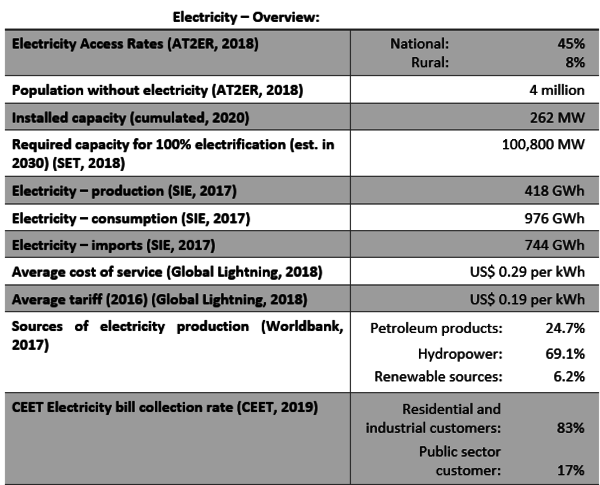
Renewable Energy
Solar Energy
Currently, many projects are being implemented that use solar energy. PV systems can be used flexibly at utility or small scale to generate electricity. Utility scale solar power plants can thus directly feed the public power grid with electricity. Mini-Grid and Off-grid-systems are smaller solar fields providing electricity directly to remote villages and rural communities that do not yet have access to the grid. But also, single private households can be supplied with electricity by solar-home-systems (SHS) and solar kits.
Utility scale: The first large photovoltaic solar power plant with a total capacity of 50 MW will be built in the town of Blitta by the end of October 2020. The project will be implemented in two phases: the first phase of 30 MW, which will be commissioned at the end of June 2020, and the second phase of 20 MW, which will follow at the end of October 2020. The plant is to improve the quality of the national electricity supply. (AT2ER, 2018)
An announcement for another major project was made in December 2019. Scaling Solar which was initiated in Togo by the Togolese government in cooperation with the Togolese Agency for Rural Electrification and Renewable Energy (Agence Togolaise d'Electrification Rurale et des Energies Renouvelables - AT2ER) and IFC, launched a tender to build and operate two grid-connected PV solar plants based on an IPP. The total cumulative capacity is expected to be around 60 to 80 MWp. The two systems will be installed in Kpalassi in Awandjélo in the Kara region and in Salimdè in Sokodé in the central region of Togo.
Mini-Grid and Off-Grid systems: In addition to the planned large solar power plants, several Mini-Grid and Off-Grid systems already exist. In order to ensure the optimal operation and sustainability of these solar mini power plants, the Ministry of Energy and Mines is hiring KYA-Energy Group to assist the Directorate General of Energy (DGE) in monitoring, managing and operating these mini power plants. (Prof.AZOUMAH, 2019)
Solar Home Systems (SHS) / Solar Kits: Another way to supply private households with electricity is to use solar kits . Solar kits are PV systems for individual use and can be used to supply electricity to individual electrical devices or entire households. There are already several companies and projects active in this field to spread the use of solar kits throughout the country (see chapter 6). (Global Lightning, 2018)
Hydropower
Hydropower is one of the main sources of base load electricity generation. Togo's hydropower potential is highly seasonal, with seasons varying from region to region. The main current use of hydropower potential is focused on the Mono River. However, operating data from the Nangbeto power plant have shown that the Mono River has a triple degree of variability: event-driven, seasonal and multi-year. This makes this source an "opportunity resource" which must have an "equivalent resource in reserve" in the CEET and CEB supply park, otherwise technical failures cannot be avoided in the event of a sudden drought and very high replacement costs may be incurred in the event of a prolonged drought. Therefore, any additional development must consider these event-driven (torrentiality), seasonal and multi-annual intermittent operations. In order to continue exploiting the capacities of the Mono River, a rehabilitation of the Nangbeto dam is planned. Another project on the Mono River is located in Adjarala. The Adjarala site has been the subject of several studies, the results of which are still open to question. On the other hand, small rivers and streams could be exploited for small (less than 10MW) hydroelectric projects. There is certainly an urgent need to develop small hydropower plants for the supply of electricity to rural areas and remote communities. (PERC, 2015)
In Togo, the government is planning to develop an energy program under the PND in addition to the Kpimé dam, "which should help to exploit the hydropower potential through the construction of dams (Tététou (50 MW), Danyi-Konda (10 MW), Baghan (6 MW), Landa-Pozanda (4 MW)). (Togofirst, 2018)
Another project to be implemented shortly is the construction of a 24 MW hydropower plant in Sarakawa. The project is being developed on behalf of the Togolese Agency for Rural Electrification and Renewable Energy, Agence Togolaise d'Electrification Rurale et des Energies Renouvelables (AT2ER) and with support of the French Development Bank, Agence Francaise de Développement (AFD). The power plant is expected to provide electrification for up to 29 communities in the region. The project aims to reduce electricity supply shortages at a time of rapidly growing demand, to reduce Togo's dependence on electricity imports from neighboring countries and to expand access to electricity throughout the West African country. The implementation of this project falls within the framework of the electrification strategy. (AT2ER, 2019) (Hydropower-Dams)
Table 3 Overview of all planned and already operated hydropower plants in Togo. The largest hydropower plant, the Nangbeto Hydropower Plant, has been in operation for several years and makes a major contribution to the electricity supply in Togo. Many smaller power plants are already planned.
Energy from Biomass
Direct use of Biomass: Vegetal biomass consists of forest resources and plants wastes. In Togo, household energy consumption is characterized by a very strong predominance of the Biomass. According to the 2017 report of the Togo Energy Information System (SIE), the share of biomass-energy reaches 76% of the national final consumption against 20% for petroleum products and 4% for electricity. Togolese citizens, whether rural or urban, mainly use the only energy resource available nationally, renewable and economically accessible: wood.
Based on the results of the in-depth study on the dynamics of wood-energy use in Togo by UCN REDD+, the volume of wood-energy consumed by households and socio-professional groups is estimated at 7,500,000 m³/year. In rural areas, the energy needs of the majority of the households are still met by charcoal and firewood. This predominance is also observed in previous studies (DGE 2007: 87%, QUIBB 2016: 86.9%).
Cooking technologies are diversified according to the place of residence (rural or urban) and have a significant impact on the quantity of fuel consumed by households. The use of improved cook stoves would save 30% about 1.5 million tons of wood per year. Several types of traditional and improved cook stoves are used in Togo. The most common are among others, the ASUTO stove, improved conical UB stove, the NANSU stove, the Improved three stone stove made with clay. These improved stoves are used more in urban than rural areas,
for the simple reason that the use of charcoal is higher in large cities. In Togo, nearly 82% of rural households have only a traditional 'Three Stones' stove for cooking with wood. The share of the population using improved stoves was 6.55% in 2010, it is estimated at 27% in 2020 (PANER 2015). These rates remain quite low for the achievement of the sustainable forest management objectives at national level, so it is necessary to take real account in designing new projects in the energy and environmental sector. It is in this context that in developing the National Action Plan for Renewable Energies (PANER) in 2015, Togo has set some key objectives for the 2020-2030 period, which include, among others, significant growth of the rate of use of improved stoves for cooking estimated to 27% in 2020 and 80% in 2030, to increase the charcoal production efficiency from 15% to 25% through the use of improved Kilns and to increase the rate of LPG use in domestic energy to 25% in 2020 and 75% in 2030.
Conversion of biomass into electrical energy : As described, the majority of the biomass is not used for electricity generation. Firewood and charcoal are mainly used as direct forms of energy in households (90,6% Firewood and charcoal). However, biomass can also be used to generate electrical energy in biogas plants. Other renewable raw materials besides wood can also be used for this purpose. Apart from wood, Togo has a wealth of unused biomass (land and water weeds), to which household waste, animal excrement (cow dung, pig manure, excrement of small ruminants and poultry) and other vegetable waste can be added. All these organic materials, to which biodegradable waste from food factories can be added, represent an important raw material for the production of biogas for domestic or public use (electricity production). Waste recycling is progressing well in Togo under the leadership of the Laboratory for Waste Management, Treatment and Recovery of the University of Lomé. At present, the electrical energy produced from biogas plants is classified as renewable energy, which accounts for a total of 0.4% of electrical energy production in Togo. (PERC, 2015)
Wind Energy
Compared to solar energy, wind energy is making a tentative start in Togo. So far it has only been used to pump groundwater. Initial explorations had shown that the Togolese wind resource is not competitive compared to other sources on utility-scale. (PERC, 2015)
Fossil Fuels
Currently, seven power plants are operated with fossil fuels in Togo with a cumulated capacity of ~260 MW. These so-called thermal power plants use thermal gas, thermal oil and thermal DDO to produce electrical energy. Most of the power plants of this type are managed by the grid operator and utility CEET. The largest two run by CEET are located in the capital Lomé and have a capacity of 12MW each.
The largest thermal power plant in Togo is operated by Contour Global, a private company and has a capacity of 100 MW. The power plant can be operated with natural gas or heavy fuel oil as main fuel and diesel as reserve. This "tri-fuel" approach offers a high degree of flexibility, as it provides a quick change of fuels in case the primary fuel type is not available.
Even more thermal power plants are planned for the future. Like the Kékèli power station from the EranoveGroup which will reach an output of 65MW after completion. (AFDB, 2015) (CEET, 2020)
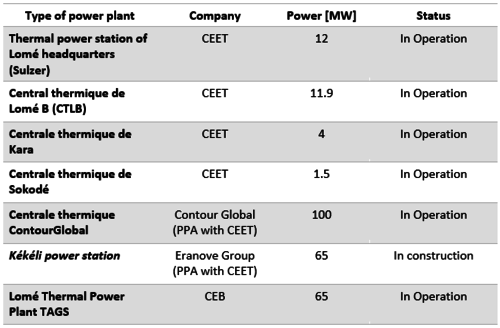
Key Problems of the Energy Sector
Electrification of rural Areas.
The Togolese energy sector, particularly in rural areas, is characterized by inadequate or missing infrastructure, expensive connections, low supply and poor quality of supply. The electrification rate per inhabitant in 2019 is 45 % nationwide, but only 8 % of rural areas are electrified. Economic potentials and employment opportunities are not fully exploited. Value creation in rural areas is insufficient, and the social infrastructure such as schools, health stations or public lighting is not sufficiently developed or not functional. Where there is already an electricity supply, even on a small scale, the use of electricity is mostly limited to lighting and charging mobile phones and less to productive processes. However, a large part of the rural population still has no access to electricity and has to resort to flashlights, petroleum lamps or candles for lighting. Renewable energies for productive and value-adding processes are not very widespread, so that the agricultural economy is characterized by a low level of processing and value creation. This leads to low household income, which makes rural areas unattractive for desirable private sector investments in Mini-Grids or individual solar systems. In June 2019, a decentralization process was initiated which potentially gives decentralized local authorities more competence and decision-making power in the energy sector. This opens up potential through new actors, planning, activities and participation at local level. In addition, the sector is in the process of being regulated (e.g. in terms of feed-in and tariffs). (WB Appraisal, 2017)
This decentralization process is foreseen in the National Development Plan (Plan National de Développement, PND), which focuses on the use and expansion of solar energy. The Togolese government has thereby launched a much-admired and highly praised program. The Togolese Agency for Rural Electrification and Renewable Energy (AT2ER) is to partly carry out and support its implementation, especially the Electrification Strategy. The organization is responsible for coordinating with private actors for rural electrification. One of the rural off-grid electrification projects will provide electricity to 9 villages through the supply and installation of photovoltaic solar panels. In addition, several hundred solar kits will be used. Another initiative is the CIZO project, which uses a PAYGO marketing system to electrify over 2 million inhabitants, which is equivalent to 300 000 households, with solar panels within 5 years. With the same method, thousands of public institutions and businesses will be equipped with individual solar or 3000 irrigation kits. A further plan to electrify rural areas sustainably with solar energy is taking place within the framework of a public-private partnership (PPP) contract. The aim is to find private companies to build, operate and maintain the power generation and distribution facilities in the project locations. AT2ER aims to provide a financial equilibrium for the operators thanks to the revenues from the sale of electricity, which will allow them to finance the maintenance and renewal of all the installations. (Global Lightning, 2018)
Security of supply, reliability and efficency of electricity supply
Grid Stability: The energy sector in Togo has other structural problems besides the task of providing access to electricity for the entire population. Despite being connected to the electrical grid, this does not mean that it can be used without interruption. This is because unreliable imports and a lack of domestic power sources increase the frequency of power cuts. Due to lack of investment in the distribution system and its maintenance, the system also suffers from severe voltage drops and high system losses.
Dependence: The problem is exacerbated by the fact that Togo imports a large part of its electricity from neighboring countries and is therefore dependent on regional electricity trading. Electricity is imported from Nigeria and Ghana via the CEB interconnectors, with the remainder being supplied by the Contour Global power plant and other smaller domestic sources. Nevertheless, regional electricity trading has a positive impact on the energy sector and economy of Benin and Togo.
This is because the cost of imported electricity is lower than the cost of supplies from national thermal power plants. However, electricity exports have not always been reliable, due to inconsistent hydrological conditions, the unavailability of gas or operational constraints. In addition, Togo is heavily indebted to the utilities in the exporting countries, which has a negative impact on the reliability of imports from these countries.
Debt: The high system losses and dependence on neighboring countries result in an inefficient value chain. This results in a very high average electricity tariff, which is among the highest in sub-Saharan Africa (19 USc$/KWh). Nevertheless, it is still far below the generation costs (29USc$/kWh) (Global Lightning, 2018).
According to the World Bank the main reasons for this imbalance are a systematic lack of planning capacity, the absence of an operational regulator with a systematic pricing mechanism, the absence of an operational regulator with a systematic pricing mechanism, an outdated organizational and legal framework as well as poor utility performance and the lack of financial resources for new investment and the attraction of the private sector to an unsustainable situation.
The large imbalance between generation costs and the electricity tariff is one of the reasons for the high indebtedness of the electricity sector. The CEB has debts of several hundred million US dollars with electricity companies in Ghana, Nigeria and Côte d'Ivoire. Concerns about the level of this debt have led to diplomatic actions of various kinds on behalf of the energy exporting countries, such as the settlement of intergovernmental arrears.
Structural problems: However, the lack of sector planning tools prevents the government from developing a roadmap on how to improve service and reduce costs and limits the government's ability to attract investment in the electricity sector. The World Bank proposes that the government and the CEB work together to develop a master plan for generation and transmission that includes long, medium and short-term investments and can include solar IPPs and other renewable energy projects. In addition, investments in transmission and distribution have been neglected over the last 20 years and must now be prioritized. This can be done by improving the quality and quantity of services and by rehabilitating and strengthening distribution networks in urban and peri-urban areas. (WB Appraisal, 2017)
Policy Framework, Laws and Regulations
Togo electrification strategy
Togo recognizes that access to electricity is an essential element of its economic development and inclusive growth policy and is one of the major pillars that will enable the implementation of its new National Development Plan. Togo's ambition is to ensure universal access for all Togolese by 2030, with a 100% access rate over the next ten years. This will be achieved through an intelligent combination of network extension and off-grid solutions (Mini-Grids and solar-kits).
The Government of Togo is counting on the mobilization of private sector investment, through Public Private Partnerships (PPPs) and targeted support mechanisms enabling, for example, the most vulnerable populations to have access to electricity. Through this Vision Togo wants to demonstrate that it is possible to electrify a country in twelve years
Therefore, Togo aims to use the latest technologies and business models. The electrification of the country is based on three pillars. The national power grid, Mini-Grids and Solar-kits for solar home systems (SHS).
The national strategy is based on the most cost-effective approach for identify the technologies to be deployed on the territory. A geospatial model was designed based on digital cartography in order to obtain an overview of the demand for electricity and the possibilities for technical implementation. The result was a comprehensive Database indicating the least-cost electrification solution for each settlement in Togo.
To achieve 100% electrification of all areas, almost 50% of the additional households can be supplied with electricity via off-grid systems. Figure 8 Overview of the geospatial modelling based on digital cartography to show the possibilities for technical implementation (SET, 2018)shows the different ways of accessing electrical energy. Finally, Figure 9 shows the three different forms of electrification and electricity distribution in Togo. This is divided into the national power grid, decentralized mini-grids and solar kids for private and individual use. In the southernmost region Maritime with the capital Lomé, 41% of the electricity users are supplied by the local power grid. As population density decreases towards the north, the expansion of the grid also decreases. In the northernmost region of Savanes, however, the use of solar kids dominates. The use of mini-grids is the least widespread throughout the country.
Energy Sector and Policy Framework
The energy sector is centrally anchored in the National Plan for Sustainable Development 2018-2022 (Plan national de développement, PND). The rural electrification sector is directly anchored in the third axis of the PND (consolidation of social development and strengthening inclusion). However, the first and second axes of the plan (establishment of a logistics and financial hub; development of processing centers for agriculture, manufacturing and extractive industries) also make direct reference to the energy sector as a transversal basis for sustainable economic development. The national electrification strategy adopted in June 2018 details the objectives of the PND. Togo's energy policy goal, as set out in the strategy, is to ensure access to environmentally friendly and competitive energy for the entire population by 2030. There is also fundamental coherence with Sustainable Development Goal (SDG).
The energy sector is assigned a priority role in the Togolese government's National Determined Contributions (NDC) to the Paris Agreement. This applies above all to the biomass and renewable energy (RE) sub-sectors. In 2015, three strategic documents described goals and measures to improve the institutional and regulatory conditions of the energy sector. These are mainly oriented towards achieving the SDG and especially SDG 7.1 - the achievement of universal access to energy by 2030. In addition, Togo has set itself clear targets in the NDC sector, with 11.14% greenhouse gas reduction by 2030. The national electrification strategy consists of three pillars: i) the supply of up to 550,000 households in rural areas with individual solutions for sustainable basic energy supply (EGV) through "Solar Home Systems" (SHS) and ii) the construction and operation of up to 315 hybrid (min. 75% RE) village power plants (mini-grids). iii) the expansion of the conventional power grid in up to 960 villages, is indirectly supported by the improvement of framework conditions. (GIZ, 2019)
Renewable Energy Act
In the area of the legal framework, three implementing ordinances for the RE Act were passed by parliament. These are texts on (i) the regulation of modalities for grid-based electricity production, (ii) the setting of approval thresholds (capacities) for electricity production from RE and (iii) the granting of licenses for the decentralized production and marketing of electricity from RE. A fourth implementing regulation to regulate the grid injection of RE for small producers is in its first reading. (GIZ, 2019)
The Renewable Energy Law: This law establishes the general legal framework for the implementation of electricity generation projects based on renewable energy sources, either for own consumption or for commercialization. It defines the legal regulation of the installations, equipment, materials and movable and immovable goods necessary for the production, storage, transport, distribution, marketing and consumption of electricity from renewable energy sources.
This law applies to all areas of renewable energies for the production of electrical energy, namely:
- Solar (photovoltaic and thermodynamics): conversion of solar radiation into electricity;
- Biomass: conversion of organic matter, waste, biogas, biofuel into electricity;
- Wind: conversion of wind into electricity;
- Hydropower: conversion of the potential energy of water into electricity;
- Waves or tides: Converting the kinetics of waves and ocean currents into electricity;
- Geothermal energy: conversion of heat from the depths of the earth into electricity;
- all other renewable energy sources that can be converted into electricity
This law also applies to the safety, operation, storage, marketing and security of renewable energy sources. The provisions of this Act therefore apply to all the above-mentioned renewable energy sources and any other form of renewable energy relevant to electricity generation. (Loi Energie, 2018)
The decrees: There are various decrees that specify the Renewable Energy Sources Act for individual measures. The decrees serve:
- to determine the performance thresholds of the various legal regulations for electricity generation projects based on renewable energy sources (Decret N°2019-019, 2019)
- to determine the conditions for concluding and terminating concession agreements for the generation and marketing of electricity from renewable energy sources (Decret N°2019-018, 2019)
- to determine the conditions for granting and withdrawing the license for the generation, distribution and marketing of electricity from renewable energy sources (Decret N°2019-021, 2019)
- or for the Creation, allocation, organization and functioning of the Togolese "ageance d'électriffication rurale et des énergies renouvelables" (AT2ER). (Decret N°2016-064, 2016)
Institutional Set up in the Energy Sector
Responsible for the energy sector in Togo is the Ministry of Mines and Energy (Ministère des Mines et de l'Énergie MME). It is responsible for the planning, organization, coordination, monitoring and development of all activities related to mining and energy. It is also responsible for satisfying national demand and ensuring the self-sufficiency and security of the supply of electrical energy. An important aspect of this is the control and guarantee of the energy infrastructure. In addition to the maintenance and expansion of the infrastructure, great importance is also attached to the research and use of renewable energy, which is supported by national and international funds.
The regulation authority (Autorite de reglementation du secteur de l’ectricite , ARSE), a subdivision of the MME, is an administrative authority that is an integral part of the State but enjoys financial autonomy by law. It assists the Minister responsible for energy in managing activities in the electricity sector. ARSE is required to keep complete, regular and accurate accounts of its income and expenditure, which are submitted annually to the Court of Auditors for audit. The role of the regulatory authority is to regulate activities related to the generation, transmission and distribution of electricity. This includes monitoring the activities of electricity distributors to ensure that consumers have continuity and quality of supply under the prescribed conditions. It also monitors compliance by operators with their obligations, the technical, economic and financial performance of the electricity sector and the development of the implementation of the general policy of organization of the electricity sector.
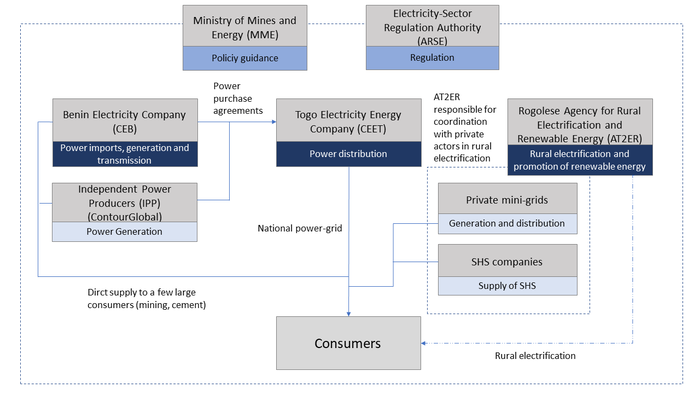
The general mission of the national utility, the Togo Electric Energy Company (CEET), is to ensure the public service of distribution and sale of electricity throughout the national territory, in compliance with the standards in force for the generation, transmission and distribution of electricity. The main tasks that define the mission of the CEET are the supply and distribution of electricity and effective pricing, while ensuring quality and continuity. While CEET owns and focuses on distribution in the medium-voltage and the distribution grid. CEB operates the high voltage network. CEET also generates electricity (see chapter 3). (CEET, 2020)
The Benin Electricity Company (CEB) is a Benin-Togolese joint venture responsible for electricity generation, imports and transmission in both countries. The company also operates Togo's largest hydropower plant at the Nangbeto dam and a thermal power plant in the port of Lomé. CEB directly supplies some large electricity consumers such as industries in mining or cement production. For the other part, the business groups have a power purchase agreement with the CEET. (CEB, 2020)
Another important player in the energy sector is the Togolese Agency for Rural Electrification and Renewable Energies (AT2ER), a public institution, with financial autonomy. The agency is in charge of implementing the country's rural electrification policy, promoting and developing renewable energies. As a central player dedicated to the development of renewable resources, AT2ER aims to transform the country's natural energy potential into electrical energy for the development of rural localities. Thus, AT2ER has the double responsibility of accelerating rural electrification and increasing the share of renewable energy in Togo's energy mix. Henceforth, any intervention with the aim of guaranteeing electricity supply to rural populations is ensured by the agency. In order to realize their plans, AT2ER directly supports private and independent companies that take care of the distribution of SHS systems or plan and install mini-grid systems. (AT2ER, 2018)
Solar home systems (SHS) can be used to supply electricity to private households that are not connected to the grid. AT2ER supports the projects not only with technical knowledge but also with new intelligent marketing models. The organization is in contact with private small and medium-sized enterprises to advise them on the production, distribution and maintenance of SHS. So far, there are five companies holding a license in the framework of the CIZO project allowing them to commercialize SHS in Togo: BBOXX, SOLEVA, Fenix, Moon and Solergie (TogoFirst, 2020)
In addition, mini-grid systems will be built in rural areas. These will be used to supply electricity to remote communities that are not yet part of the public grid. In order to promote the expansion of the Mini-Grid systems, AT2ER regularly issues are preparing a public tender to which companies can apply. Currently, 3 to 5 private partners are being sought for the construction, operation and maintenance of 317 mini-grids. Besides the mini-grids and SHS companies which are in private hands, there is also a large power plant that is privately operated. (AT2ER, 2018)
The independent power producer (IPP) Contour Global operates the largest thermal power plant in Togo. This covers a large part of the domestic electricity production. Like CEB, the power plant supplies electricity directly to large consumers or feeds the electricity into the public grid where it is distributed by CEET. In addition to the existing power plant, another thermal power plant is planned in Kekeli which is currently in the construction phase.
The local private companies import, sale or install renewable energy equipment for the electricity production. They have formed into different associations or group to contribute better in Togo’s electricity access. We find GREAT (Groupe de Réflection sur les Energies Alternatives au Togo), RePER (Réseau des Professionnels des Energies Renouvelables), APERT (Association pour la Promotion des Energies renouvelables au Togo), and RESER (Réseau sous Régional de la Recherche en Energie Renouvelables)
They are not sufficiently involved in the implementation of the electrification strategy. However, some through their leaders participate in national workshops on energy issues. It should also be noted that some companies among the associations between them carry out projects with the communities for their access to electricity.
Other Key Actors / Activities of Donors, Implementing Agencies, Civil Society Organisations
Further Information
- Togo subsidies off-grid solar to extend electricity access to all
- USAID Power Africa: Togo Factsheet
References
- ↑ Togo, Konsulat. 2020. Konsulat Togo. [Online] 2020. http://www.konsulat-togo.de/geographie.php.
- ↑ 2.0 2.1 Worldbank. 2017. Worldbank. [Online] 2017. http://documents.worldbank.org/curated/en/918921468338492241/pdf/multi-page.pdf.


